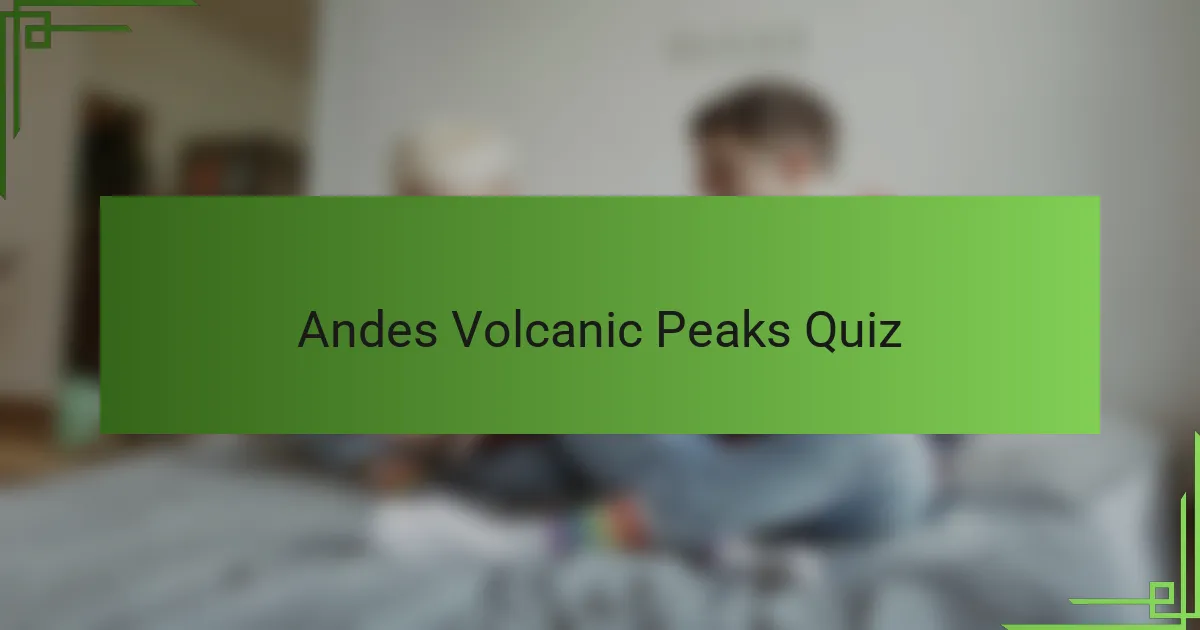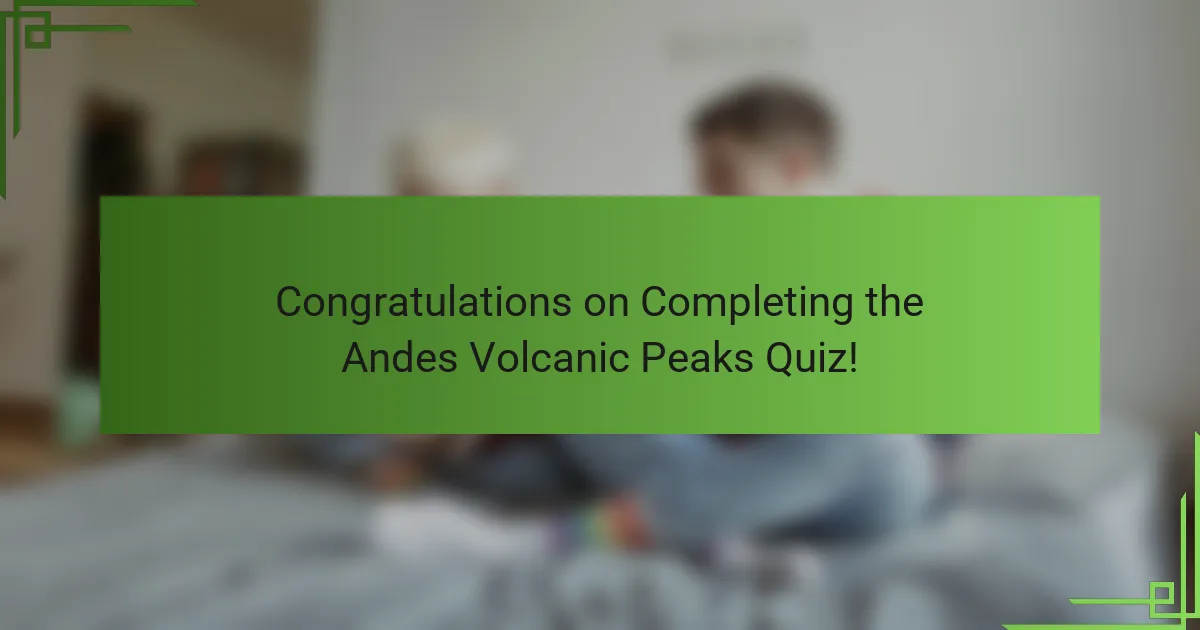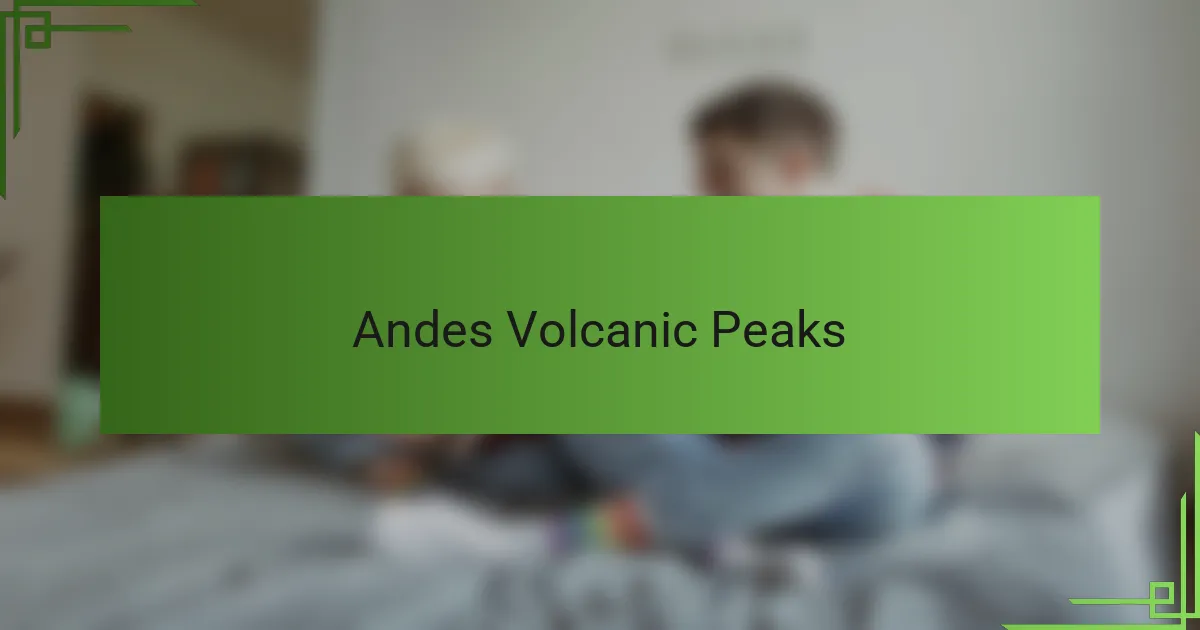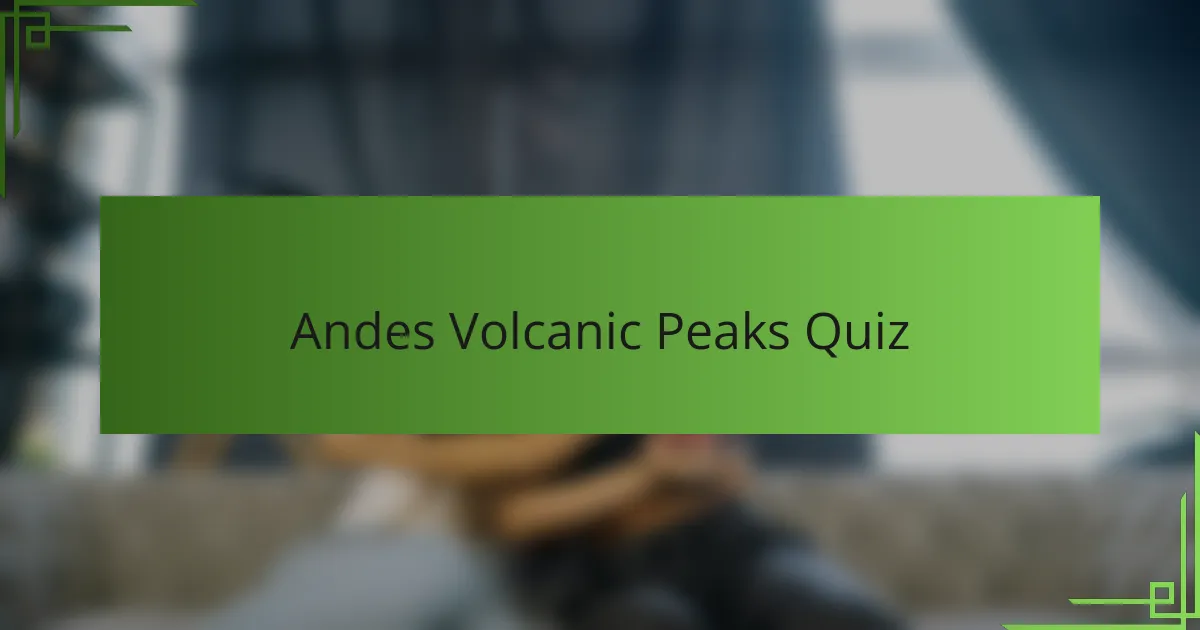
Andes Volcanic Peaks Quiz
1. What is the highest volcanic peak in the Andes mountain range?
- Ojos del Salado
- Cotopaxi
- Nevado Tres Cruces
- Chimborazo
2. Which Andes volcano is known as the tallest active volcano in the world?
- Parinacota
- Llullaillaco
- Nevado Tres Cruces
- Ojos del Salado
3. In which country is the Andes volcanic peak Ojos del Salado located?
- Peru
- Bolivia
- Argentina
- Chile
4. What is the geological term for the volcanic mountain range that runs through the Andes?
- The Circum-Pacific Ring
- The Central American Volcanic Chain
- The Pacific Volcanic Arc
- The Andean Volcanic Belt
5. Which famous Andes volcano last erupted in 2015 and is located in Chile?
- Osorno
- Calbuco
- Villarrica
- Llaima
6. The Andes volcanic peaks are part of which tectonic plate boundary?
- The boundary between the Cocos Plate and the Caribbean Plate
- The boundary between the Pacific Plate and the Antarctic Plate
- The boundary between the North American Plate and the Eurasian Plate
- The boundary between the Nazca Plate and the South American Plate
7. What is the name of the volcanic peak in the Andes that is considered the second highest volcano worldwide?
- Nevado Tres Marías
- Llullaillaco
- Tres Cruces
- Ojos del Salado
8. Which Andes volcano is known for its massive caldera and is located on the border of Argentina and Chile?
- Nevado Tres Cruces
- Caldera de Llullaillaco
- Laguna del Maule
- Ojos del Salado
9. How do volcanic peaks in the Andes impact the climate and agriculture of the surrounding regions?
- The volcanic peaks primarily cause frequent ash fall that limits agriculture but increase rainfall due to volcanic steam emissions.
- The volcanic peaks increase temperatures significantly, allowing tropical crops to be grown at higher altitudes.
- The volcanic peaks create dry rain shadows that prevent any type of agriculture in the surrounding areas.
- The volcanic peaks provide rich volcanic soils that enhance agricultural productivity while also affecting local microclimates by influencing moisture distribution.
10. Which city lies closest to the volcanic peak of Mount Chimborazo in the Andes?
- Loja
- Ambato
- Cuenca
- Riobamba
11. What volcanic Andes mountain is also famous for being the refuge of ancient Incan ruins?
- Chimborazo
- Machu Picchu
- El Misti
- Cotopaxi
12. What role does the Nazca Plate subduction play in the formation of Andes volcanic peaks?
- The Nazca Plate subducts beneath the Pacific Plate, forming volcanic peaks on the ocean floor that later rise to form the Andes.
- The Nazca Plate subducts beneath the South American Plate, causing melting in the mantle that forms magma feeding the Andes volcanic peaks.
- The Nazca Plate collides head-on with the South American Plate, causing direct uplift of volcanic peaks without magmatic activity.
- The Nazca Plate moves laterally along the South American Plate, creating volcanic peaks through crustal stretching.
13. Which Andes volcano has the notable feature of a large glacial ice cap despite its tropical location?
- Cotopaxi
- Nevado del Ruiz
- El Misti
- Chimborazo
14. How does the height of Andes volcanic peaks compare to other major volcanic mountain ranges worldwide?
- The Andes volcanic peaks are among the tallest volcanic mountains globally, with many exceeding 6,000 meters.
- The Andes volcanic peaks are generally shorter than those in the Cascade Range in North America.
- The Andes volcanic peaks are mostly under 4,000 meters, making them modest in height globally.
- The Andes volcanic peaks are lower on average than the volcanoes in the East African Rift.
15. Which volcano in the Andes is considered sacred in indigenous South American cultures and is part of the Central Volcanic Zone?
- Parinacota
- Ojos del Salado
- Licancabur
- Llullaillaco

Congratulations on Completing the Andes Volcanic Peaks Quiz!
You’ve reached the end of our quiz on the Andes Volcanic Peaks, and it’s great to see your dedication to learning about this fascinating geographical region. This quiz has offered you insights into some of the highest and most active volcanoes in the world. By engaging with the questions, you’ve reinforced your understanding of volcanic formations, their locations, and their significance within the Andes mountain range.
Throughout this quiz, you might have discovered interesting facts about volcano activity, elevation differences, and the cultural importance of these peaks. Understanding the Andes’ volcanic peaks helps deepen your appreciation of Earth’s dynamic processes and the way landscapes are shaped over time. These insights are key to grasping broader concepts in physical geography and geology.
We encourage you to explore our next section on this page, which expands on the Andes Volcanic Peaks with detailed information, maps, and visuals. This will help you build on what you’ve learned and provide a clearer picture of the region’s geological features. Keep exploring and stay curious about the world’s incredible geography!

Andes Volcanic Peaks
Geographical Overview of the Andes Mountain Range
The Andes is the longest continental mountain range in the world, extending about 7,000 kilometers through seven South American countries: Venezuela, Colombia, Ecuador, Peru, Bolivia, Chile, and Argentina. It forms the western backbone of South America and affects the continent’s climate, biodiversity, and human settlement patterns. The range includes a series of high peaks, extensive plateaus, and volcanic zones, with many peaks rising above 6,000 meters.
Formation and Tectonic Setting of Andes Volcanic Peaks
The volcanic activity in the Andes is primarily caused by the subduction of the Nazca Plate beneath the South American Plate. This convergent plate boundary leads to magma generation, giving rise to numerous volcanic peaks along the Andes. This volcanic arc is part of the Pacific Ring of Fire, characterized by frequent earthquakes and active volcanoes such as Cotopaxi and Ojos del Salado, some of the highest volcanoes in the world.
Key Volcanic Peaks in the Andes and Their Characteristics
Notable volcanic peaks include Ojos del Salado, the highest active volcano globally at 6,893 meters, located on the Argentina-Chile border. Cotopaxi in Ecuador stands at 5,897 meters and is one of the most active volcanoes worldwide. Llaima in Chile is another major volcanic peak noted for its frequent eruptions. These volcanoes vary in activity, structure, and geological composition, influencing local landscapes and ecosystems.
Volcanic Activity and Hazards in the Andes Region
Andes volcanic peaks exhibit a range of eruptive behaviors, from explosive eruptions to lava flows, posing risks such as ashfall, pyroclastic flows, and lahars to nearby populations. Notable eruptions like the 1999 Cerro Hudson event in Chile caused widespread disruption. Monitoring by geological agencies like SERNAGEOMIN in Chile and IGEPN in Ecuador are essential for detecting volcanic unrest and mitigating hazards.
Impact of Andes Volcanic Peaks on Regional Geography and Climate
Volcanic peaks in the Andes shape the topography by creating high altitudes and influencing river systems through lava flows and volcanic deposits. They affect local climates by altering wind patterns and precipitation distribution, often creating rain shadows and microclimates. Additionally, volcanic soils derived from eruptions are fertile, supporting agriculture and affecting human settlement patterns in countries like Peru and Bolivia.
What are the Andes Volcanic Peaks?
The Andes Volcanic Peaks are a series of volcanoes located along the Andes mountain range in South America. These peaks are primarily stratovolcanoes formed by tectonic activity along the Pacific Ring of Fire. Notable examples include Ojos del Salado, the highest active volcano in the world at 6,893 meters, and Mount Chimborazo in Ecuador. Their volcanic activity is a result of the Nazca Plate subducting beneath the South American Plate.
How are the Andes Volcanic Peaks formed?
The Andes Volcanic Peaks are formed through the subduction of the Nazca Plate beneath the South American Plate. This tectonic process causes melting of mantle material, creating magma that rises to the surface and forms volcanoes. This mechanism is responsible for the volcanic activity along the Andes, part of the Pacific Ring of Fire. Geological studies confirm this subduction zone as the main cause of the formation of these volcanic peaks.
Where are the Andes Volcanic Peaks primarily located?
The Andes Volcanic Peaks are primarily located along the western edge of South America, spanning countries such as Chile, Argentina, Peru, Ecuador, Bolivia, and Colombia. They follow the entire length of the Andes mountain range, which extends over 7,000 kilometers. For instance, many significant peaks like Ojos del Salado are situated on the border between Chile and Argentina.
When did the volcanic activity of the Andes Volcanic Peaks begin?
The volcanic activity of the Andes Volcanic Peaks began during the Cenozoic Era, around 65 million years ago, when the subduction of the Nazca Plate started under the South American Plate. This tectonic interaction has persisted, leading to continuous volcanic activity recorded throughout geological history up to the present day, with some volcanoes such as Villarica and Cotopaxi known to have erupted in recent centuries.
Who studies the Andes Volcanic Peaks?
The Andes Volcanic Peaks are studied by geologists, volcanologists, and geophysicists from universities and research institutes worldwide. Notable institutions include the Chilean National Geology and Mining Service (SERNAGEOMIN) and the United States Geological Survey (USGS) Volcano Hazards Program. These experts analyze volcanic activity to understand eruption patterns and associated risks, using data from seismic monitoring and satellite imaging.
